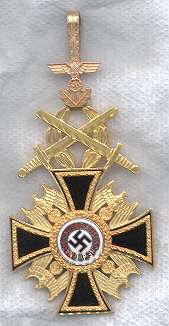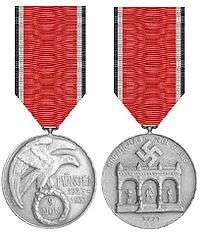Political decorations of the Nazi Party
Political decorations of the Nazi Party were medals and awards issued by the National Socialist German Workers Party (NSDAP) between 1920 and 1945. Political awards were authorized for wear on any paramilitary uniform of Nazi Germany, as well as civilian attire, but were generally frowned upon for display (but not forbidden) on active duty military uniforms of the Wehrmacht. The Waffen-SS freely wore both political awards and military decorations on their uniforms.
Civil decorations were considered the lowest order of medals, after military decorations and political decorations of the Nazi Party. Civil decorations were authorized for display on civilian clothing and paramilitary uniforms of the Nazi Party; however, their wear was often prohibited on active duty military uniforms of the Wehrmacht; the notable exception to this were sports badges, which were granted the same status as military qualification awards.
Political decorations
The various degrees of Nazi Party decorations were as follows:
| The German Order (Awarded with and without Swords) |
|---|
 |
| Golden Party Badge | The Blood Order |
|---|---|
 |
 |
German Order
This was the highest award that the Nazi Party could bestow on an individual. Adolf Hitler regarded this award as his personal decoration to be bestowed only upon those whose services to the state, party, and the people, he deemed worthy. There were eleven confirmed recipients of this award between 1942 and 1945.[1][2]
Golden Party Badge
The first 100,000 members who had joined and had uninterrupted service in the Nazi Party were given the right to wear the Golden Party Badge (Goldenes Parteiabzeichen), shown above. Those badges had the recipient's membership number on the back (Adolf Hitler had badge #1). Other Golden Party Badges (with the initials A.H. on the back) were awarded at the discretion of Hitler to certain members of the party who merited special attention. An identical badge was awarded each year on 30 January to persons who had shown outstanding service to the Party or State.[3]
Blood Order medal
The Blood Order (German: Blutorden), officially known as the "Decoration in Memory (of the Munich putsch) of 9 November 1923" (Medaille zur Erinnerung an den 9. November 1923), was one of the most prestigious decorations in the Nazi Party. During March 1934, Hitler authorized the Blood Order to commemorate the 9 November 1923 coup attempt of the NSDAP.[4]
Party badges
- Coburg Badge
- Nuremberg Party Day Badge (1929)
- Brunswick Rally Badge (1931)
- Frontbann Badge
- Danzig Cross (awarded in 1st and 2nd class)
- NSDAP Long Service Award: Given in three grades; awarded for 10, 15, and 25 years of service
- Honour Chevron for the Old Guard: Designated those who joined the Party before Hitler became Chancellor. It was worn on the right sleeve.
The leaders of Nazi political districts (known as the Gauleiter) were empowered to bestow Gau Badges for a variety of services rendered to the local political organization. The badges were issued in Silver and Gold with some issuance in Bronze. They were rarely issued in Gold with Diamonds.[5]
In November 1936, Hitler gave new "orders" as to the "Orders and Awards" of the Nazi Party to be bestowed. The top NSDAP awards are listed in this order: 1. Coburg Badge; 2. Nuremberg Party Day Badge of 1929; 3. Brunswick Rally Badge (SA Treffen at Brunswick 1931); 4. Golden Party Badge; 5. The Blood Order; followed by the Gau badges and the Golden HJ Badge.[6]
SS and Police decorations
- SS Chevron for Former Police and Military
- SS Membership Runes for Order Police
- SS Long Service Award
- Police Long Service Award
- Totenkopf Ring
- SS Honor Sword
- SS Julleuchter
- SS Zivilabzeichen
Germanic-SS decorations
Awards specific to individual nationalistic Germanic-SS organizations were as follows:[5]
- Germanic Proficiency Runes (bronze and silver)
- SS Sports Badge (Netherlands)
- SS Honor Sports Badge (Netherlands)
- Brave and Faithful Order (Norway)
- Førergarde Membership Badge (Norway)
- Front Fighters Badge (Norway)
- Mussert Cross (Netherlands)
- Mussert-Garde Commemorative Pin (Netherlands)
- Schalburg Cross (Denmark)
- State Police Honor Cross (Norway)
- W.A. Sports Badge (Netherlands)
SA decorations
- SA Sports Badge (bronze, silver and gold)
- Service Entry Badge of Der Stahlhelm, Bund der Frontsoldaten
NSFK decorations
Hitler Youth decorations
Hitler Youth awards were as follows:[8]
- Hitler Youth Badge
- Hitler Youth Badge for Distinguished Foreigners
- Hitler Youth Leader's Sports Badge
- Hitler Youth Skier Badge
- Hitler Youth Marksmanship Badge
- Hitler Youth Proficiency Badge
Other German sports decorations
- German Olympic Decoration (awarded in 1st and 2nd class)
- German Sports Badge
- Horseman's Badge
- Horse Driver's Badge
Civil awards
- German National Prize for Art and Science
- Badge for the Academy of Aeronautical Research
- National Senate of Culture Badge
- Goethe Medallion for Art and Science
- National Food Estate Medallion
- Social Welfare Decoration (awarded in 1st, 2nd and 3rd class)
- Medal of Social Welfare
- Faithful Service Medal (gold, silver and special class)
- Cross of Honor of the German Mother (bronze, silver, and gold)
- Lifesaving Medallion
- Fire Brigade Decoration (awarded in 1st and 2nd class)
- Mine Rescue Medal
- Civil Defense Decoration (awarded in 1st and 2nd class)
- War Merit Medal
Diplomatic awards
- Grand Cross of the Order of the German Eagle
- Special Grade Order of the German Eagle
- Order of the German Eagle (five classes)
- Medal of the Order of the German Eagle (bronze and silver)
All German Eagle decorations were awarded both with and without swords and could be upgraded to a gold version and also gold with diamonds. The German Eagle was intended as an award for foreigners while the Special Grade (without degree) was awarded to Germans.
Labor and trade decorations
- Pioneer of Labor Award
- Fritz Todt Award
- Reichsberufswettkampf
- Defense Economy Leader's Badge
- Customs Service Decoration
- Labor Service Ribbon (for 25, 18, 12, and 4 years of service)
Red Cross awards
- German Red Cross Decoration (awarded in four classes)
- Red Cross Medal
Notes
- Angolia 1989, p. 224.
- Gerwarth 2011, p. 279.
- Angolia 1989, pp. 178–179.
- Doehle 1995, p. 71.
- Lumsden 2001.
- Angolia 1989, p. 197.
- Doehle 1995, p. 122.
- Ailsby 1991.
References
- Angolia, John (1989). For Führer and Fatherland: Political & Civil Awards of the Third Reich. R. James Bender Publishing. ISBN 978-0912138169.CS1 maint: ref=harv (link)
- Doehle, Heinrich (1995) [1943]. Medals & Decorations of the Third Reich: Badges, Decorations, Insignia. Reddick Enterprises. ISBN 0962488348.CS1 maint: ref=harv (link)
- Gerwarth, Robert (2011). Hitler's Hangman: The Life of Heydrich. New Haven, CT: Yale University Press. ISBN 978-0-300-11575-8.CS1 maint: ref=harv (link)